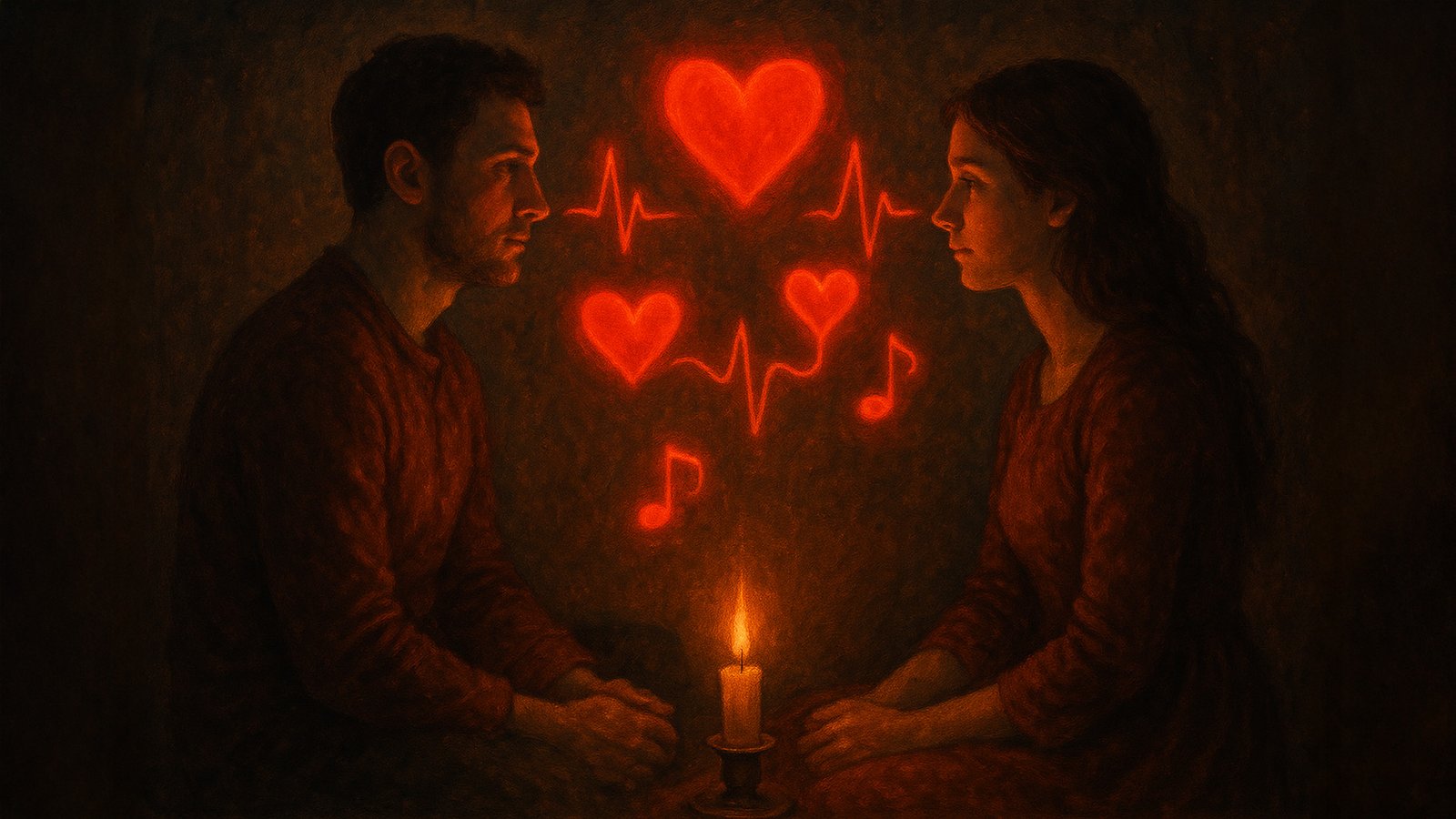When Lovers’ Hearts Beat in Sync: The Science of Staring into Eyes
Romantic heart rate sync sounds like the sort of thing a pop ballad would croon about, somewhere between star‑crossed lovers and an over‑earnest chorus. Yet here we are, with scientists wiring couples up like experimental Christmas trees and confirming that when two people sit quietly and stare into each other’s eyes, their hearts really can fall into step. Not just metaphorically, not just as a poetic flourish, but with actual synchronised beats you could plot on a monitor. It makes “my heart beats for you” less of a cliché and more of a cardiology fact.
Picture the scene. Two people sit opposite each other. No phones, no chatter, no polite fidgeting with a glass. Just three unbroken minutes of gazing. Awkward? Definitely. Romantic? Depends on your tolerance for staring contests. But while they’re locked into each other’s eyes, hidden machinery hums away beneath the surface. The electrocardiogram lines that moments earlier wobbled in their own rhythms start to echo one another. If one heart rate lifts, the other shadows it. If one dips, the partner follows. Lovers, it seems, are part‑time synchronised swimmers—only the choreography takes place under the ribs.
Psychologists have been poking at this for years. Arthur Aron, the man behind the infamous “36 questions to fall in love” experiment, ended his protocol with four minutes of uninterrupted eye contact. Many participants reported surges of intimacy, a few went on dates, and one couple famously married. Whether their hearts synced in the moment, nobody can say, but the anecdote feeds the mythos: eye contact is a fast‑track intimacy drug, and our bodies are willing accomplices.
The hard science arrived when researchers at UC Davis hooked couples up to heart monitors. The volunteers sat apart, didn’t touch, didn’t even speak, and were asked to simply be. Their physiological data betrayed what their poker faces didn’t: hearts and breathing fell into parallel rhythms. Shuffle the data and try matching partners at random, and the synchrony disappears. Lovers’ bodies seem tuned to one another, ready to hum in unison given half a chance.
What’s even stranger is that this doesn’t stop at hearts and lungs. Put couples under EEG caps or fMRI scanners and watch as their brainwaves begin to pulse in tandem during moments of eye contact. Neural synchrony, the researchers call it, which sounds suspiciously like something lifted from a sci‑fi film. Strangers can achieve this too, but the effect tends to be strongest among the romantically entangled. Your brain, it seems, is not above performing a duet when it finds the right partner.
Of course, not every three‑minute gaze session feels transcendent. Some people report sweaty palms, nervous laughter, or the irresistible urge to look anywhere but those eyes. Eye contact at length can feel confrontational, even invasive. The synchrony doesn’t care, though. Even as you squirm, your body quietly adjusts its tempo to match the other’s, like a bashful band still playing in time.
Sceptics might wonder if this isn’t just wishful thinking dressed up in heart rate graphs. But data from blind date experiments piles on more evidence. When strangers met under lab conditions and sat gazing for two minutes, the ones who later rated each other as attractive and interesting were the pairs whose physiological signals had synchronised most closely. Forget witty banter and perfectly timed jokes; the real flirtation might be happening in your autonomic nervous system.
If you want a dose of irony, synchrony doesn’t belong to lovers alone. Parents and infants sync up during cuddles. Therapy clients and counsellors fall into physiological step when a session goes well. Even teammates in cooperative games show parallel shifts in skin conductance as they strategise. We’re social creatures with built‑in metronomes that want to tick together. Romance just happens to be the most glamorous example.
So what does romantic heart rate sync actually mean for couples outside the lab? You can imagine it as nature’s subtle nudge, reinforcing bonds by making two bodies feel like they belong in the same rhythm. Oxytocin and dopamine play their parts, of course, but there’s something seductively simple about the idea that your heart literally keeps time with someone else’s. Shared playlists and Spotify algorithms be damned—your cardiovascular system is already doing the mixing.
Therapists have cottoned on. Eye‑gazing exercises feature in relationship workshops, designed to remind couples what it feels like to be present rather than distracted by notifications. The point isn’t just romance; it’s recalibration. Three minutes of seeing and being seen can reset a rhythm that daily stress scrambles.
But let’s not get too misty‑eyed. Not all synchrony is bliss. Couples in conflict can also sync up physiologically, but the beat reflects stress and tension rather than harmony. Matching heart rates might just as easily signal shared anxiety as it does mutual affection. In other words, your partner’s pounding chest during a row doesn’t mean you’ve reached some cosmic union; it means you’re both stressed out at the same tempo.
Still, the idea retains its allure. In a world that measures everything—steps, calories, likes—romantic heart rate sync feels like a secret metric, a private signal hiding in the body’s rhythms. No app required, no algorithm selling you ads, just a low‑tech, high‑intimacy form of connection. Next time you’re across the table from someone you care about, try the three‑minute gaze. It might feel daft at first. You might laugh, you might fidget, you might think about the washing up. But give it time and your hearts might conspire to whisper, in syncopated beats, a message older than any science: you and I, here, together.
